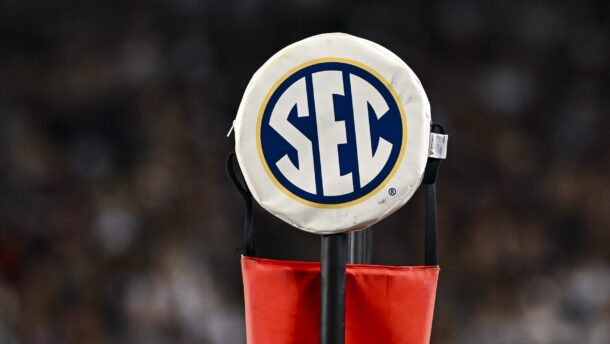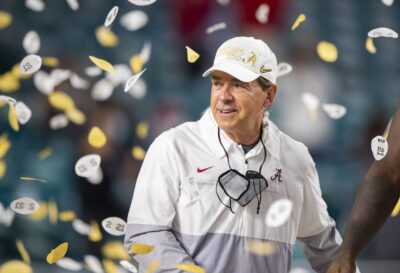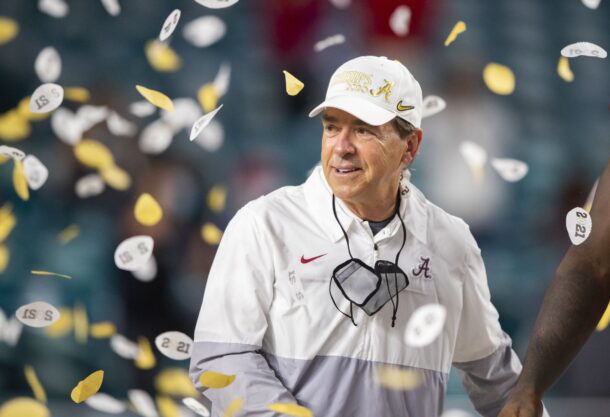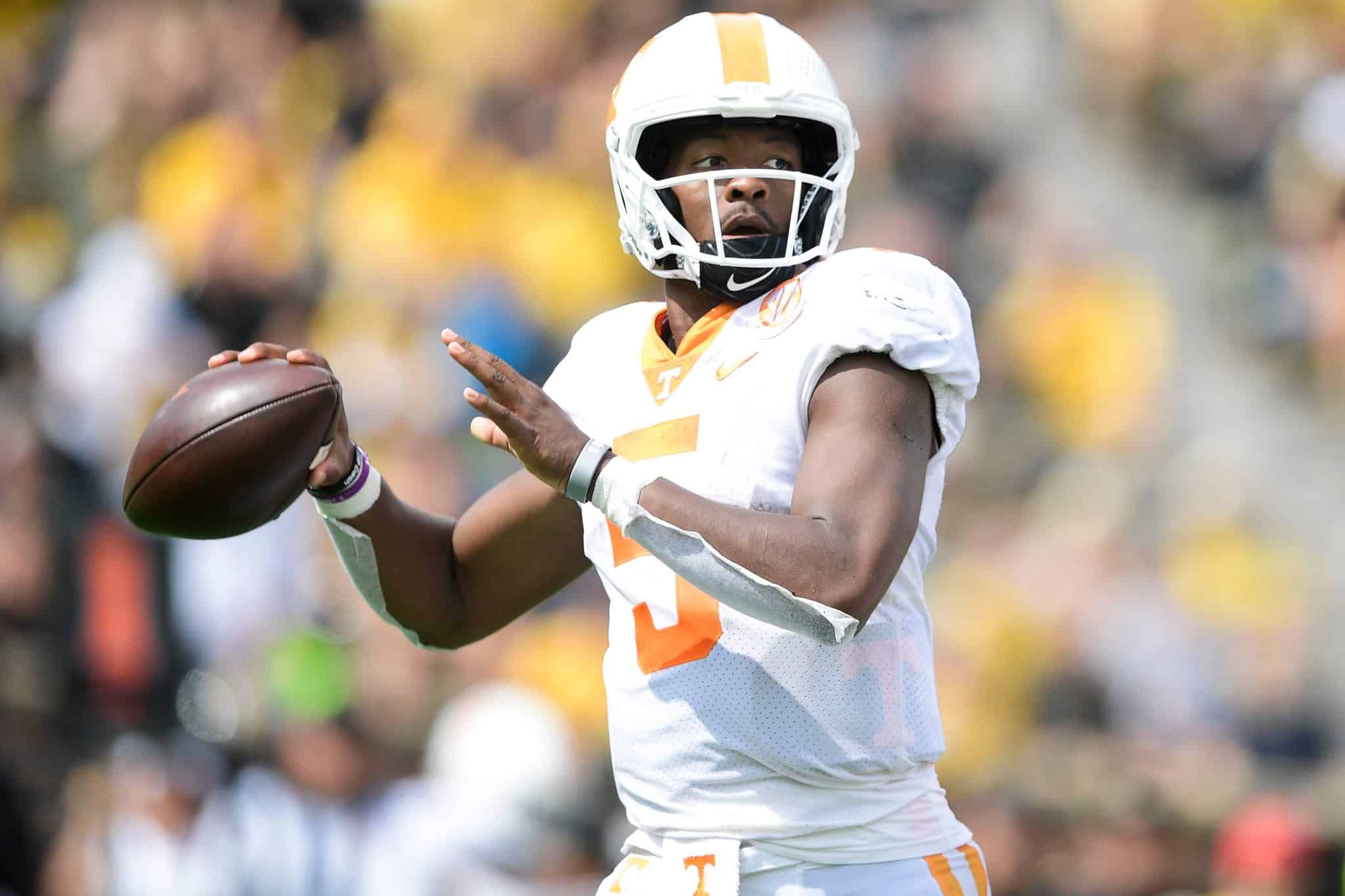
Scouting Hendon Hooker: QB points the way forward for Tennessee
By Matt Hinton
Published:
Quarterback: The most important position in football, and a position of strength across the SEC in 2022. Each week this summer, QB Class will dive deep on a projected SEC starter — the good, the not-so-good, and what to expect in the upcoming season. Today: Tennessee’s Hendon Hooker.
Typecasting: The bridge
In an endlessly frustrating era for Tennessee football, no player has been the focus of more frustration than Jarrett Guarantano. Poor Jarrett. Over the course of 32 career starts and more than 800 attempts from 2017-20, he served dutifully as the face of a program in desperate need of a scapegoat, and which reliably found one in its beleaguered, bizarrely long-tenured quarterback. As QB1, Guarantano was booed, benched, un-benched, written off, berated on national TV, and somehow kept coming back for more. He presided over 3 losing records in 4 years and the firing of 2 head coaches, as grim a run as any in school history.
So, in the spirit of turning the page, the moment was ripe in 2021 for the next guy to win over the fans. Enter Hendon Hooker, a veteran, dual-threat transfer from Virginia Tech with 15 starts as a Hokie and a clean slate as a Vol. Although similar to Guarantano in terms of size (6-4, 218) and mobility, as a passer he was everything in his first season in Knoxville his predecessor was not: Accurate, efficient and risk-averse. After taking over the starting role in Week 2, Hooker went on to set school records for completion percentage (68.0) and overall passer rating (181.4) while posting the best TD-to-INT ratio (31-3) of any full-time FBS passer. Tennessee scored 45+ points in 6 of its last 9 games and improved its ppg average vs. Power 5 opponents by 2 full touchdowns.
From the outside, the turnaround was easy to miss. The Vols’ 7-6 record was par for the course, in large part due to a defense that ranked among the SEC’s worst in yards and points allowed. They were never ranked and soundly beaten in their most high-profile games against Alabama, Georgia and Florida, extending their losing streaks in each rivalry. Hooker himself was rarely singled out as an emerging star or touted as a future pro. For a national audience, the most memorable moment was a borderline revolt by the home crowd near the end of a dramatic, exhausting loss vs. Ole Miss, which resulted in a brief stoppage as the field was strewn with debris.
Compared to the previous status quo, though, Hooker was an obvious upgrade who brought a new degree of stability to the position, and whose return for his 6th year of eligibility is the main reason for optimism in 2022 – a word that hasn’t been associated with Tennessee football in quite a while. In the long run, he may not be the elite talent who gets the Vols all the way back to where they expect to be. For now, those kinds of expectations are reserved for 2023 commit Nico Iamaleava, who’s poised to become Tennessee’s Tennessee’s first 5-star QB in more than 20 years. But to the extent that Hooker has played a role in making Knoxville a viable destination again for that type of talent under coach Josh Heupel, he’s already done what he was brought aboard to do.
The good
The most reassuring part of Hooker’s résumé is what isn’t there: Picks. Three interceptions on 402 dropbacks in 2021 represented the best rate of any Power 5 quarterback. Factor in multiple touchdown passes in 10 of 12 games, and you have a stat line the NCAA’s pass efficiency formula was specifically built to love. Hooker’s efficiency rating led the SEC and ranked No. 3 nationally, coming in nearly 14 points ahead of Bryce Young’s (albeit on significantly fewer attempts).
Elsewhere, the verdict was slightly less enthusiastic. Hooker landed squarely into the “good not great” range according to both Pro Football Focus, where his overall grade (84.4) ranked 33rd nationally among QBs with at least 100 dropbacks, and ESPN’s Total QBR, where he ranked 16th. That tracks with his athletic profile, in general — jack of all trades, master of none. His size, athleticism and arm talent all come in above average but short of elite. He checks all the boxes for a draftable prospect, but is unlikely to crack the tier of aspiring first-rounders.
That said, as he proved last year, Heupel’s offense doesn’t require a next-level specimen to lay waste to most of the defenses on the schedule. Although Heupel has roots in the Air Raid — as a player, he memorably led Oklahoma to a national championship running Mike Leach’s offense — his current system owes more to Baylor’s fast-and-furious approach during the Art Briles years, which coincided with Heupel’s tenure as the Sooners’ offensive coordinator. Like those old Baylor attacks, the Vols aim to stress defenses by emphasizing tempo and vertical shots: On the former note, they averaged 73.3 plays per game despite coming in dead last nationally in time of possession; on the latter, Hooker led the SEC in the percentage of his attempts that traveled 20+ yards downfield (17.4%).
Hendon Hooker DIME ? pic.twitter.com/y0pF9spcyH
— SEC Network (@SECNetwork) December 30, 2021
When it worked, it tended to work fast. Twenty-three of Hooker’s 31 TD passes came before halftime, and whenever possible Tennessee made a point of going for the jugular right out of the gate. Against Missouri, the Vols scored on all 7 first-half possessions and led 45-10 at the half. (Final score: 62-24.) The following week, they hit paydirt on 5 of their first 6 possessions against South Carolina and led 38-7 at the half. (Final score: 45-20.) Against Kentucky, Hooker’s first 2 completions went for touchdowns covering 75 and 72 yards, respectively, in what turned out to be a back-and-forth shootout. (Final score: UT 45, UK 42.) Against Purdue in the Music City Bowl, he connected with Cedric Tillman on first-quarter touchdowns covering 41 yards (see above) and 61 yards, kicking off one of the wildest games of the postseason. (Final score: Purdue 48, UT 45 in overtime.)
Even more so than for Hooker, who had 5 TD passes on the day, the bowl game was a breakout performance for Tillman, who was quietly one of the SEC’s most productive receivers in 2021 and is arguably the league’s most proven returning wideout in ’22. (The only other name in the argument being LSU’s Kayshon Boutte.) A late bloomer with just 8 receptions in his first 3 years on campus, Tillman caught fire around midseason, hauling in 10 touchdowns in the last 7 games and going over 100 yards in five of the last 6. Replacing outgoing WRs Velus Jones Jr. and JaVonta Payton is a priority, but if the offense manages to level up against the likes of Alabama, Georgia, Florida, and LSU, the chemistry between Hooker and Tillman will be the reason.
The concerns
Although Hooker was very good at not putting the ball at risk in 2021, part of the reason for that was the ball was often never leaving his hands. He was sacked 41 times, the most of any SEC quarterback, and also had the most scrambles on designed passes, with 56. Put those numbers together, and nearly 25% of his total dropbacks ended without a pass attempt — far and away the highest percentage in the conference. For a dual threat, Hooker was also a relatively containable target under duress, taking sacks on 32.8% of pressured dropbacks, per Pro Football Focus. Again, that was the worst rate in the SEC.
The biggest question mark at the next level will be his downfield accuracy. Hooker’s 37.7% completion rate on attempts of 20+ yards was right around the national average. But as aggressive as he was on deep shots, Tennessee’s boom-or-bust approach to the passing game limited his opportunities in the intermediate 10-to-20-yard range that includes most varieties of what are considered “NFL throws,” which only accounted for an SEC-low 17.1% of his total attempts. (He was the only QB in the conference who threw deep more often than intermediate.) The remaining two-thirds fell into the 0-to-10-yard range or behind the line of scrimmage, which boosted his completion percentage more than his stock.
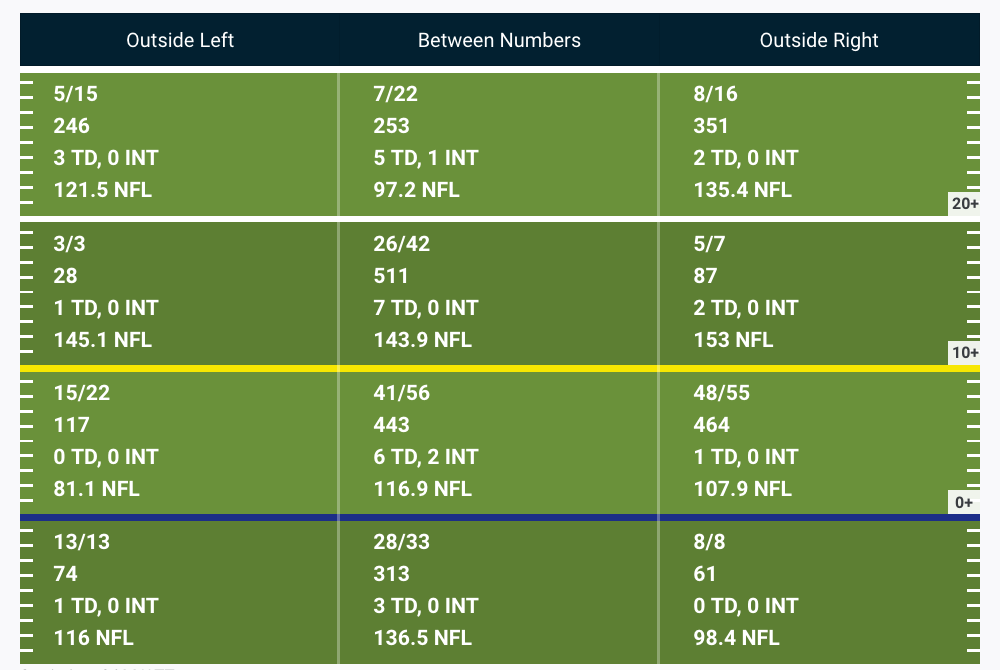
Hendon Hooker 2021 attempts by location (via Pro Football Focus)
– – –
That’s a very “college offense” chart, with sideline attempts in the 10-to-20-yard range — deep out territory — virtually nonexistent. The limited sample size suggests Hooker is capable of making those throws, but with so few of them on the record, it’s not an area that’s going give opposing secondaries much concern or that scouts are going to mark down as a plus.
The backup plan
As a starter, Joe Milton was a disappointment, lasting barely 6 quarters in the job last September before his chronic inaccuracy sent him to the bench for good in Week 2. As a backup, he’s a luxury: A 5th-year player with significant experience and the complete set of physical tools. There’s certainly no shortage of younger QBs around the league with better long-term prospects, including the name just below Milton’s on the depth chart, incoming freshman Tayven Jackson. But as far as being ready to roll on short notice in 2022, Milton is arguably the SEC’s most seasoned backup in a pinch.
Assuming he sticks around for his final year of eligibility, he’ll also be in line to reclaim the job in 2023, at which point the situation gets more complicated. Given Milton’s obvious struggles last year, and at Michigan prior to that, Jackson, Iamaleava, and/or a veteran transfer to be named later figure to have every opportunity to overtake him. Barring disaster, that’s an issue for next spring. For now, all he needs to be is a viable Plan B.
The forecast
Like most players in the post-graduate phase of their careers, Hooker is an unlikely candidate for a breakthrough in Year 6. The cake is baked. At 24, he’s relatively old for the college game and probably maxed out athletically. He’s played a ton of snaps against quality competition. All signs suggest the guy the Vols saw in 2021 is the finished product.
But that guy is certainly one they can win with, and it doesn’t take any wild leaps of imagination to see how a repeat of last year’s performance on offense could give Tennessee a fighting chance in the SEC East. Tillman is on track for a huge year, the defense is due for a turnaround, and with Florida and LSU both in rebuilding mode the only games on the schedule that figure to kick off with the Vols as substantial underdogs are dates with Alabama and Georgia. Vegas set the over/under for Tennessee at 7.5 wins, a bar it’s cleared just 3 times since 2008. But if Hooker’s efficiency carries over there’s a plausible path to nine, possibly even ten.
That’s the glass-half-full version, anyway, which admittedly for a fan base conditioned to brace for the opposite might sound like a sucker’s bet. Half the schedule falls squarely into the toss-up column, as usual. And even if a steadier version of the status quo is enough to flip a couple of the heartbreakers, closing the gap on the league’s top tier remains a question for two or three years down the line. On that front, Iamaleava’s commitment was a big win that should pay dividends in selling other blue-chip recruits with no memory of Tennessee’s heyday on the program’s potential. In the meantime, Hooker’s job is to keep the momentum sustaining that vision alive.
Matt Hinton, author of 'Monday Down South' and our resident QB guru, has previously written for Dr. Saturday, CBS and Grantland.
